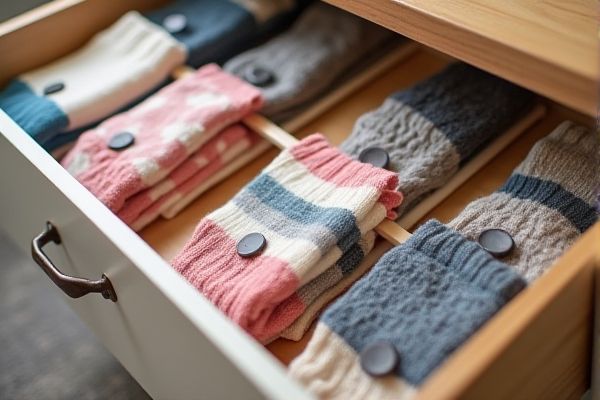
A sock organizer typically features specific compartments designed to keep socks neatly paired and easy to find, while drawer dividers offer a more flexible solution for segmenting various items in a drawer beyond just socks. Explore the rest of this article to discover which option best enhances your drawer organization and suits your needs.
Table of Comparison
| Feature | Sock Organizer | Drawer Divider |
|---|---|---|
| Purpose | Specifically designed to store and separate socks | Versatile, used to divide drawers for various items |
| Material | Soft fabric, mesh, or plastic compartments | Plastic, wood, metal, fabric, adjustable materials |
| Size & Shape | Compact compartments tailored for socks | Adjustable or fixed length to fit drawer width |
| Installation | Placed inside drawers or hung | Installed inside drawers, adjustable or fixed |
| Use Cases | Organizing socks, underwear, small accessories | Organizing clothes, utensils, office supplies, or accessories |
| Cost | Usually inexpensive, budget-friendly | Varies, can be affordable to premium prices |
| Customization | Limited to compartment size and count | Highly customizable and adjustable to drawer size |
Introduction to Sock Organizers and Drawer Dividers
Sock organizers and drawer dividers both enhance closet organization by maximizing space and improving accessibility. Sock organizers are specifically designed with compartments to neatly separate pairs of socks, minimizing clutter and time spent searching for matches. Drawer dividers offer versatile sections for various clothing items, allowing you to customize your storage and maintain a tidier drawer environment.
Purpose and Benefits of Sock Organizers
Sock organizers are specifically designed to neatly separate and store individual pairs of socks, preventing them from getting lost or mismatched. They optimize drawer space by providing dedicated compartments that maintain order and visibility, making it easy to find socks quickly. Unlike general drawer dividers, sock organizers offer tailored sizing and structure that cater to the unique shape and quantity of socks, enhancing overall drawer organization and longevity of sock fabric.
Advantages of Using Drawer Dividers
Drawer dividers maximize space efficiency by creating customizable compartments that keep socks neatly separated and easy to access. They prevent clutter by maintaining order within mixed laundry drawers, reducing the time spent searching for matching pairs. Durable materials and adjustable designs offer long-lasting organization solutions adaptable to various drawer sizes and contents.
Material and Design Differences
Sock organizers typically feature soft, fabric-based compartments designed for flexible storage and gentle protection of delicate textiles, whereas drawer dividers are often made from rigid materials like wood, plastic, or metal to create firm, adjustable sections within drawers. Drawer dividers prioritize customizable length and sturdy separation to fit various drawer sizes and prevent items from shifting, while sock organizers emphasize breathable materials and modular pockets for ease of access and visibility. The choice between these solutions impacts durability, maintenance, and the type of clothing items best accommodated, with sock organizers favoring softness and drawer dividers highlighting structural support.
Space Efficiency: Which Saves More Room?
Sock organizers maximize space by offering customized compartments that prevent socks from tangling and collapsing, allowing for vertical stacking and better visibility. Drawer dividers segment larger spaces into adjustable sections suitable for various items but often create wasted gaps due to rigid sizing. Studies show sock organizers can save up to 30% more space in drawers compared to traditional adjustable dividers, making them superior for compact storage solutions.
Ease of Installation and Use
Sock organizers typically feature flexible compartments that require no assembly, allowing for quick placement inside drawers and immediate use. Drawer dividers often involve adjustable or collapsible panels that can be customized to fit various drawer sizes but may need initial setup, which can take more time. Both solutions enhance drawer organization, but sock organizers offer greater ease of installation and usability due to their ready-to-use design.
Customization and Flexibility Options
Sock organizers offer enhanced customization with compartments designed specifically for socks, allowing you to adjust sizes or add layers tailored to your collection. Drawer dividers provide versatile flexibility by fitting various drawer shapes and can separate multiple item types beyond socks, adapting to your changing storage needs. Your choice depends on whether you prioritize dedicated sock organization or a multifunctional system suitable for diverse belongings.
Maintenance and Cleaning Comparison
Sock organizers often feature flexible mesh or fabric compartments that can be easily removed and machine-washed, ensuring hygienic storage with minimal effort. Drawer dividers, typically made of rigid materials like wood or plastic, require manual wiping or spot cleaning, which may be less convenient for maintaining cleanliness. Choosing a sock organizer simplifies maintenance due to its washable design, whereas drawer dividers demand more frequent, hands-on care to prevent dust and dirt accumulation.
Cost Comparison: Sock Organizer vs Drawer Divider
Sock organizers typically range from $10 to $25, offering affordable options for various materials like fabric, plastic, or bamboo. Drawer dividers, depending on their adjustability and material--wood, metal, or plastic--can cost between $15 and $40, often reflecting higher durability and customization features. Choosing between them depends on budget constraints and the desired balance between cost efficiency and organizational versatility.
Which Organizer is Right for You?
Sock organizers provide specialized compartments designed to keep socks neatly paired and easily accessible, ideal for those with extensive sock collections seeking quick retrieval. Drawer dividers offer versatile sectioning suitable for managing multiple clothing types within a single drawer, perfect for users who want flexible storage solutions beyond just socks. Choosing between a sock organizer and a drawer divider depends on your specific storage needs, drawer size, and preference for compartmentalization versus versatility.
 homyna.com
homyna.com